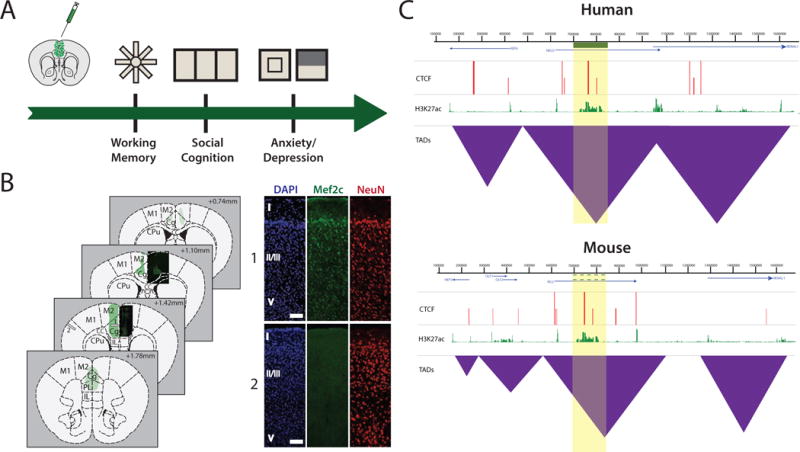Figure 1.

(A) Examples of schizophrenia-relevant behavioral assays in mice with genetically engineered (incl. virus vector-mediated transgene expression) PFC, including radial arm maze for working memory, three chamber social interaction choice, and the anxiety-related open field and light/dark box assays. (B) Representative serial sections of adult mouse brain tissue collected three weeks after infusion of human synapsin 1 promoter-driven AAV8-Mef2c-GFP as described[Mitchell and others 2017]. Areas shaded in green depict regions of viral expression in neurons, complemented by histological images near the injection site. Cortical distribution of Mef2c-GFP in neurons is shown in image set 1. GFP expression is not observed outside the PFC or neighboring regions (image set 2). Both sets correspond to gray bars 1 and 2 in the coronal diagram at +1.42mm. Scale bar = 50μm for both image sets. (C) Hypothetical 1.6 megabase-wide chromosomal locus with substantial epigenomic and genomic conservation in human and mouse cells with a hypothetical risk haplotype (green bar, yellow shade) associated with genetic risk for schizophrenia. There is conservation of mouse and human epigenomic landscapes, including similarities in linearly arranged gene order, and peak distributions for the CTCF chromosomal loop organizer and transcriptional regulator, and histone acetylation landscapes including histone H3-lysine 27 (H3K27ac) broadly associated with promoter and enhancer sequences[Zhou and others 2011]. There are similarities in organization of self-folding topologically associated chromatin domains (TAD)[Huang and others 2015]. Therefore, at this hypothetical locus, genomic and epigenomic editing in mouse prefrontal cortex and other anatomical structures associated with the circuitry of psychosis, may affect cognition and behavior.
